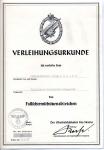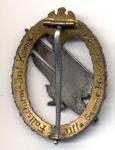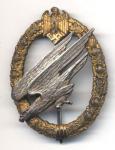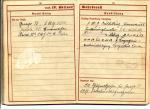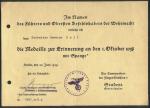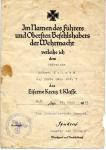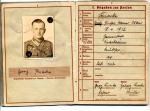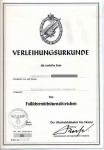-
Posts
2,284 -
Joined
-
Last visited
-
Days Won
6
Content Type
Profiles
Forums
Blogs
Gallery
Events
Store
Everything posted by PKeating
-
Some of the entries are obvious but does anyone have any ideas regarding the meaning of the "Franco-Britannique croix de commandeur pour services rendus à la cause des alliés" and the "Croix du Combattant de l'Europe". The "croix commémorative de la Libération" could be the Cross of Lorraine-style medal. PK
-

Heer Army Parachutist Badge - Type 1 "Transitional"
PKeating replied to PKeating's topic in Wehrmacht Medals, Decorations & Awards
Here you go, Steve: http://gmic.co.uk/index.php?showtopic=40074&pid=370935&st=0&#entry370935 Cheers, PK -

EK 1939 Speaking of UGLY EK2's
PKeating replied to Kriztofer's topic in Germany: All Eras: The Iron Cross
The cores of some Zimmermann EK1 do tend to flake off. I have had two L/52 EK1 1939 with flaking paint but very little rust and a cased, vaulted screwback L/52 EK1 1914, which was very nicely made, just as chic as a 1914-1920 cross, but with the finish flaking off a core with no rust at all. PK -

EK 1914 Document - EK1 to Jew
PKeating replied to Igor Ostapenko's topic in Germany: All Eras: The Iron Cross
Bravo, Igor! Wonderful reuniting of elements of a very significant grouping. I was just looking at the 1938 photograph again, which I find extremely moving. I hope he managed to find a better life in Palestine-Israel than the life he obviously left behind him. It is precisely such personal items that emphasise the horror of something most people can only think of in terms of surreal numbers. PK -
This award document bears the hand signature of Fritz Prager, CO of II./Fallschirmjäger-Rgt 1 from 1938 to 1940 and then of II./Fallschirmjäger-Rgt 3, before he was forced to stand down because of the cancer that killed him in December 1940. Prager had taken over from Richard Heidrich as CO of the Heer's Fallschirm-Infanterie-Bataillon in 1938, before the FIB's transfer to Luftwaffe command. He won the Knight's Cross at Moerdijk in May 1940, where he was wounded in action . This is one of the hardest RKT signatures to find, especially in view of Prager's status as a former Heer patratrooper and Knight's Cross winner. PK
-
This is not the usual Willrich postcard as autographed by Ritterkreuzträger during the war but a print on paper, probably cut from a book of the period and send to Brauer for his autograph. The reverse bears traces of having been stuck in an album. A decorated veteran of the First World War, with the EK1 1914, Bruno Brauer was appointed commander of Fallschirmjäger-Regiment 1 in 1938. He was previously CO of I./Regiment "General Göring" and I./FJR1 and was the recipient of the first Parachutist Badge awarded in 1936. Awarded the Knight's Cross for Holland in 1940, Brauer commanded FJR1 in Crete and then in Russia, before being posted to Crete as military governor in 1943, where he was generally considered by German and Greek alike as tough but far more humane than the other military governors to date. On Greece's national day, Brauer ordered the release of a hundred Cretans from German jails, including Constantinos Mitsotakis, a future Greek Prime Minister. Replaced as commander of Festung Kreta in 1944, Brauer was relieved of his command of 9. Fallschirmjäger-Division after a nervous breakdown. As a POW of the British, who gave him to the Greeks for trial for alleged war crimes during his time there as military governor. Brauer was predictably found guilty and executed. He paid for the indisputable harshness of his successor, General Friedrich-Wilhelm Müller. His remains were re-interred in the cemetery on Hill 107 in the 1970s after lobbying by the German Airborne Veterans Association. George Psychoundakis himself buried Brauer's remains. In recent years, there have been calls for a posthumous pardon, a step of which the Greek authorities are wary. This is quite a rare wartime RKT autograph. PK
-

Heer Panzer Assault Badge for 75 Engagements
PKeating replied to tyanacek's topic in Wehrmacht Medals, Decorations & Awards
-

Heer Panzer Assault Badge for 75 Engagements
PKeating replied to tyanacek's topic in Wehrmacht Medals, Decorations & Awards
Here's a genuine example belonging to a friend of mine, which we had in the reference section on our old website. PK -

EK 1939 Knights Cross im thinking of buying
PKeating replied to TheKnight's topic in Germany: All Eras: The Iron Cross
Von Krauthausen makes points that are just as valid as those made by the knowledgeable members who have commented here. He clearly knows something about Iron Crosses. We should welcome a new member who could, if his first post is any indication, prove to be amongst the 5% - 10% of active members here who do have useful knowledge and are prepared to share it. He is obviously not a native English speaker, otherwise he might have expressed his point about ignorant contributions in gentler language. It is irritating to see threads where someone asks about something in good faith and is informed, wrongly, that the object is a fake. The chap might have been about to buy it for a reasonable price and might have lost the chance as a result. If nothing else, it is a genuine EK2, as Bill Garvy points out. It might be a genuine RK conversion from the period. It certainly conforms to one way in which EK2 were converted. But without provenance, we cannot be sure. Perhaps "The Knight" could tell us how much the vendor was asking for this medal. PK -
Bonsoir kamerad! La photo de gauche montre certainement le SS-Gruppenführer Dr Enno Lolling mais je ne pense pas que l'autre officier pourrait être Laszlo Deak von Szentimre. Je n'ai pas une photo de von Szentimre mais, d'abord, ce soldat porte la Croix d'Espagne. Laszlo Deak von Szentimre était officier du Honved - l'armée hongroise - jusque 1944 donc celle-là est une décoration qu'il n'aurait pas pu gagner. En plus, cet officier porte l'insigne d'un SS-Obersturmführer mais von Szentimre était nommé directement SS-Oberführer en 1944 à cause de sa grade de colonel chez l'armée hongroise. Aussi, cet officier n'a pas non plus l'air d'un homme de 53 ans, von Szentimre étant né en 1891. Cordialement, PK Pour les amis anglophones: The photo on the left certainly shows SS-Gruppenführer Dr Enno Lolling but I don't think the other officer is Laszlo Deak von Szentimre. I haven't a photo of von Szentimre but, for a start, this soldier is wearing the Spanish Cross. Laszlo Deak von Szentimre was a Honved officer - Hungarian Army - until 1944 so could not have earned this decoration. Moreover, this officer wears the insignia of an SS-Obersturmführer but von Szentimre was directly appointed SS-Oberführer in view of his Hungarian Army colonelcy. Furthermore, this officer doesn't look like a man of 53, von Szentimre having been born in 1891.
-
I've had every type of issue Army Para Badge but never one of the private purchase badges in .800 silver so I thought "why not?" before I get out of Third Reich-related stuff definitively. This is the type identified by Eric Queen and myself as the "transitional" badge, with the die flaw on the talons caused by an attempt to modify the die to strengthen this part of the badge, normally struck in fine but very fragile aluminium. There were nine different types of Army Parachutist Badge, or ten if you count the round wire hook on some 1943/44 types as a type definition rather than a minor manufacturing variation. Of these, three were private purchase types struck in silver and engraved with the recipient's unit details, name, rank and the number of his award document or parachutist's licence. The matching award document is in the documents section. This man was one of the first couple of dozen Heer paratroopers and ended up with the DKiG. Some of you will quickly identify the man! PK
-

KENYA REGIMENT
PKeating replied to Mervyn Mitton's topic in Great Britain: Militaria: Badges, Uniforms & Equipment
Hallo Mervyn. I believe the 3rd Battalion Kenya Rifles was formed from 3rd Bn The King's African Rifles in 1963. 5th Bn The King's African Rifles became 5th Bn Kenya Rifles. You might be interested in this 1964 TIME magazine article: http://www.time.com/time/magazine/article/0,9171,897079-2,00.html. This unrest was said to have inspired wonderful film Guns at Batasi (1964), starring Richard Attenborough and Jack Hawkins. However, the film was based on the 1962 novel The Siege of Battersea by Imjin veteran Robert Holles, who also wrote the screenplay. His novel was rather prescient. Your Kenya Rifles insignia appear to be early examples. The TIME article gives an insight into largely forgotten actions during the final stages of the disintegration of the British Empire in Africa. PK -
Aah! Je dirais plutôt la Médaille d'Outre-Mer. The Overseas Medal replaced the Colonial Medal in 1962 and CB does indeed hold it with the clasps mentioned. These do belong in any Médaille Coloniale collection as it is still the original Lemaire design but with a different legend. PK


